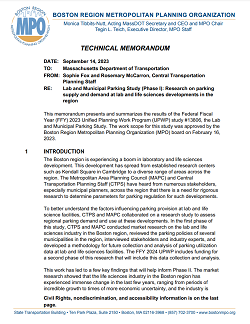Home » Information Center » Publications
September 2023
 The Boston region is experiencing a boom in laboratory and life sciences development. There is a need for rigorous research to determine parameters for parking regulation for such developments.
The Boston region is experiencing a boom in laboratory and life sciences development. There is a need for rigorous research to determine parameters for parking regulation for such developments.
To better understand the factors influencing parking provision at lab and life science facilities, The Metropolitan Area Planning Council (MAPC) and Central Transportation Planning Staff (CTPS) collaborated on a research study to assess regional parking demand and use at these developments. In the first phase of this study, CTPS and MAPC conducted market research on the lab and life sciences industry in the Boston region, reviewed the parking policies of several municipalities in the region, interviewed stakeholders and industry experts, and developed a methodology for future collection and analysis of parking utilization data at lab and life sciences facilities.
The market research showed that the life sciences industry in the Boston region has experienced immense change in the last few years, ranging from periods of incredible growth to times of more economic uncertainty, and the industry is expanding both in size and geographically. Each municipality treats lab and life science facilities differently when creating zoning ordinances, resulting in a wide range of parking requirements that are dependent on the characteristics of the buildings themselves, the accessibility of non-driving modes of transportation in the surrounding areas, the time at which the ordinances were written, and more.
The interviews with stakeholders illustrated that in addition to these parking policies, market conditions and lenders also play a large role in the final determination of how much parking developers provide at a site. The interviewees also highlighted many strategies to use existing parking space more efficiently and discourage the reliance on single occupancy vehicle (SOV) trips, such as repurposing unused parking spaces, moving towards more shared or mixed-use parking, and promoting transportation demand management (TDM) ordinances that encourage non-driving commutes. These findings have been incorporated into data collection materials that will be used in a Phase II study.
Download document:
